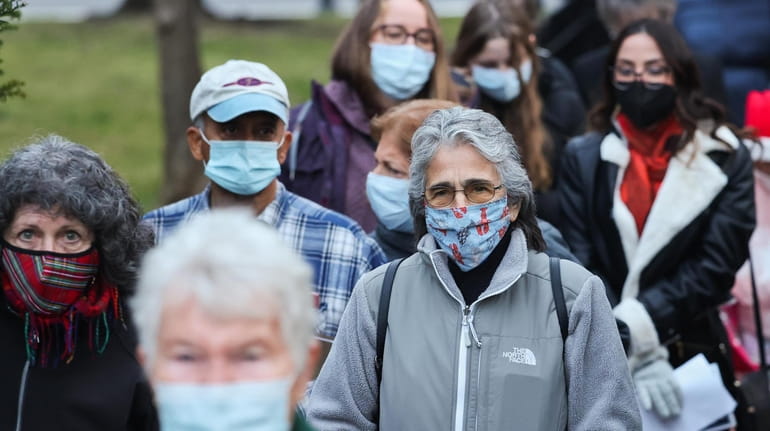Is it time to upgrade your mask? Experts answer key questions as COVID infections surge.

A crowd of people, most wearing masks, walk down an alley from Main Street in Patchogue after a show ended at the Patchogue Theatre for the Performing Arts, on Dec. 21. Credit: Newsday/Steve Pfost
Updated guidelines from the U.S. Centers for Disease Control and Prevention reduce the number of days some people who are infected or exposed to COVID-19 have to isolate or quarantine. In return, those people are being asked to wear masks when they are around other individuals.
As officials continue to rely on facial coverings as a means of controlling the spread of the coronavirus, Newsday asked two infectious disease experts from Long Island to answer some questions about masks.
Why is it so important to wear masks?
The number of COVID-19 cases on Long Island and across the state has boomed in recent weeks due to the highly contagious omicron variant. "Having a face covering is a good idea right now especially since there is such widespread transmission," said Dr. David Hirschwerk, an infectious disease specialist at Northwell Health. Hirschwerk pointed out that masks – when worn properly – reduce the risk of becoming infected and transmitting the virus to others. A properly fitted mask should cover the nose and mouth and not have gaps around the sides.
What is the current mask mandate in New York State?
Gov. Kathy Hochul announced on Dec. 10 that masks would be mandatory for people entering indoor public places unless the business or venue requires patrons to be vaccinated. Masks were already mandatory for students and staff in K-12 schools, as well as people using mass transit or entering health care facilities.
What are the most effective types of masks?
Hirschwerk said higher quality N95 masks and KN95 masks perform better than a surgical mask or a cloth mask. "The KN95s and the N95s do a much better job than the others [to prevent] becoming infected and transmitting the virus to somebody else, if you happen to be infected," he said. Both of these styles fit more snugly around the nose and mouth and provide a stronger barrier against droplets of any kind. In the early days of the pandemic, the CDC had asked people not to use N95 masks/respirators so there would be enough for health care workers. While KN95 masks are less expensive and easier to obtain than N95 masks, the CDC has warned people that about 60% of KN95 masks sold in the United States are counterfeit and not approved by the National Institute for Occupational Safety and Health.
What about surgical masks and cloth masks?
Surgical masks are cheap and plentiful, making them a good option for people who can’t afford or find N95s or KN95 masks, according to Dr. Sharon Nachman. chief of the division of pediatric infectious diseases at Stony Brook Children’s Hospital.
"Certainly an N95 would be great. ... The KN95s are also quite good, but not realistic for the majority of the population and certainly not realistic for kids," she said. "They are incredibly difficult to find and sizing is an issue."
She said people using the paper surgical masks should dispose of them at the end of the day or when they get wet and not reuse them. "If you are running into a grocery store for 10 minutes and running out, you could reuse it," she said. "But don’t reuse them multiple times during the week."
Nachman said cloth masks could be used if there are no other options.
"If you have issues with the paper mask or if your kids won’t wear the paper mask and will only wear the cloth mask, go for it," she said. "It’s better ... than wearing nothing or wearing a paper mask poorly."

